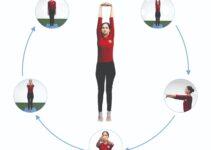Half Wheel Pose: A Simple Yoga Move with Transformative Benefits
The Half Wheel Pose, or Ardha Chakrasana, is a beginner-friendly yoga pose that gently stretches and strengthens the body. In Sanskrit, “Ardha” means half, “Chakra” translates to wheel, and “Asana” means pose. This pose focuses on improving flexibility, balance, and overall strength, making it a great addition to any yoga practice. Here’s a detailed look at how to perform this pose, its benefits, and necessary precautions.
The Half Wheel Pose is an excellent way to build strength, improve flexibility, and reduce stress. It’s accessible for beginners yet offers a variety of benefits for all yoga practitioners. By practicing this pose with mindfulness and attention to your body’s limits, you can enjoy its full range of physical and mental advantages. Always remember to modify or skip this pose if you have specific health concerns, and consult a professional if needed.

Steps to Perform the Half Wheel Pose
- Begin in Tadasana (Mountain Pose):
- Stand tall with your feet together, arms resting by your sides, and your body relaxed.
- Raise Your Arms:
- Inhale deeply and lift both arms straight up over your head, keeping them aligned with your ears. Palms can either face forward or touch.
- Bend Backward Gently:
- As you exhale, carefully arch your upper back, allowing your chest to expand.
- Engage your core muscles to provide support and ensure the bend originates from the upper back, not just the lower spine.
- Hold the Pose:
- Maintain the posture for 10–15 seconds or longer, depending on your comfort level. Focus on steady, deep breathing.
- Return to Standing Position:
- Inhale as you slowly straighten your back and lower your arms to your sides. Relax and take a few calming breaths.
Benefits of the Half Wheel Pose
1. Strengthens the Spine and Back
- Stretches and strengthens the muscles around the spine, improving posture and relieving back stiffness.
- Helps release tension in the upper and lower back, making it particularly beneficial for those who sit for long periods.
2. Enhances Lung Function
- The chest expansion in this pose improves lung capacity, promoting better breathing and oxygen flow.
3. Aids Digestion
- The gentle backward stretch stimulates the abdominal organs, aiding in digestion and enhancing metabolism.
4. Boosts Blood Circulation
- Encourages increased blood flow to the upper body and brain, reducing fatigue and improving mental clarity.
5. Improves Flexibility
- Stretches the shoulders, chest, and abdomen, enhancing overall body flexibility.
6. Reduces Stress and Anxiety
- The combination of stretching and controlled breathing helps calm the mind and alleviate stress.
7. Strengthens Core Muscles
- Activates and strengthens the abdominal muscles, contributing to improved stability and core strength.
Precautions to Keep in Mind
- Avoid if You Have Serious Back Problems:
- Those with severe back pain, herniated discs, or spine injuries should avoid this pose unless advised by a doctor or yoga professional.
- Be Cautious with High Blood Pressure:
- The backward bend can increase pressure, so individuals with hypertension should practice this pose with care or avoid it altogether.
- Prevent Neck Strain:
- Avoid overextending the neck and keep it in line with the rest of the spine to prevent strain.
- Pregnancy Considerations:
- Pregnant individuals should avoid deep backbends, including this pose, unless guided by a healthcare expert.
Tips for Beginners
- Start with a small bend and gradually increase your range of motion as your flexibility improves.
- Use a wall for balance and support if needed.
- Breathe slowly and deeply to enhance relaxation and stay focused while holding the pose.






